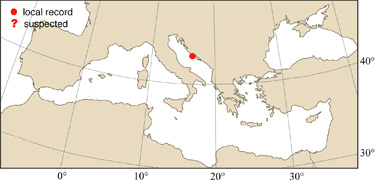
|
Relevant synonyms
Misidentification
Meristic formula
|
|
| photo : A. Zuljevic |
|
SHORT
DESCRIPTION
color : upper head, back and flank brownish-red, becoming pinkish-red on the ventral surface. Bright red spot at the base of pectoral fin. Often three white spots below dorsal fin base and two blue lines on the cheek.
size : common 20-30 cm (max.40 cm). |
DISTINGUISHING CHARACTERISTICS BIOLOGY / ECOLOGY
habitat : semi-pelagic, usually several meters above the substrate. |
|
1st
MEDITERRANEAN RECORD
|

|
|
DISTRIBUTION
|
ESTABLISHMENT SUCCESS
speculated reasons for success :
|
|
|
MODE OF
INTRODUCTION |
IMPORTANCE TO
HUMANS
|
|
KEY
REFERENCES
|
|